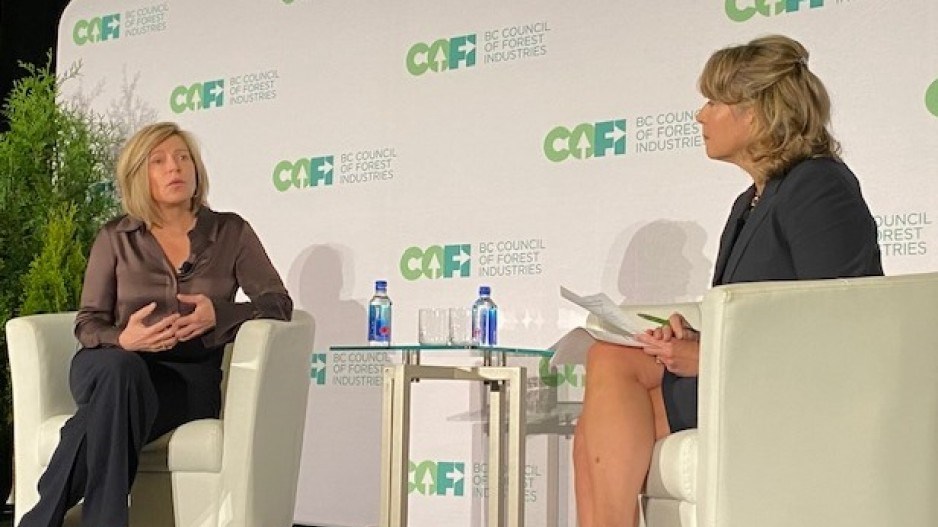With Russia’s war in Ukraine, runaway inflation and rising interest rates, analysts and economists speaking at a Council of Forest Industries (COFI) conference Thursday were openly dropping the R word.
By the end of this year or early 2023, Europe at least and possibly North America could be in a recession, some are now predicting.
That would normally be bad news for Canada’s forestry industry.
But demand for new housing is so strong in the U.S. that Paul Jannke, principal for Forest Economic Advisors, said he expects demand for lumber in the U.S. will remain strong, even with an economic contraction due to an “underbuild” of 4 million housing units and aging housing stock.
“While we have a slowdown, these markets still remain very, very strong,” Jannke said.
And the loss of lumber imports from Russia will likely mean increased demand for Canadian lumber in “non-China” Asian countries.
“We do see room for an increase in exports to non-China for North America,” Jannke said. “We’re calling for it to occur in (2023).”
He said he expects lumber prices to be in the high US$500 per thousand board feet range in 2023. That’s lower than what prices have been for the last couple of years, “but still very high prices relative to history.
“We do see prices coming off some next year, as the markets weaken…but we think that prices are still going to remain high,” Jannke said.
The average age of homes in the U.S. is 45 years, Jannke said. Even with interest rates of 5% to 6%, Jannke said it’s “entirely possible” that demand for new home construction will remain strong in the U.S., even in a high interest rate, recessionary period.
In 2021, U.S. new housing starts were expected to be 2.2 million, but there were only 1.6 million new housing starts, leaving an underbuild.
“We just simply couldn’t build it because of the supply side,” Jannke said.
In a typical recession, U.S. housing starts would fall to 1.2 million. But even if there is an economic contraction, Jannke said U.S. housing starts are expected to be 1.6 million this year and next.
“We have fundamentally strong demand over the next decade, based on age class distribution of our population, based on pent-up demand, based on the age of the housing stock but also on the reshoring of our manufacturing,” Jannke said.
While market fundamentals bode well for B.C. forestry products, there remains a laundry list of challenges domestically for B.C. lumber and pulp and paper producers, from continued logistical pinch-points to provincial policies and regulations that deter investment.
At the end of March, Canfor Corp. (TSX:CFP) announced plans to reduce operations at all of its sawmills in Western Canada, and to extend a curtailment at its pulp mill in Taylor, citing “extreme” supply chain challenges related to rail transportation.
Tracy Robinson, the new CEO for Canadian National Railway, acknowledged Thursday that CN has seemed “less than dependable” recently.
“Let’s be frank,” she said. “The business relationship between CN and this industry has been strained with all these supply chain challenges. There have been times when your sector has felt that CN was less than a dependable transportation partner.”
In addition to dealing with general logistical kinks that a global supply chain disruption has caused, CN was hit in November by floods that took out 58 sections of track over 240 kilometres in B.C. And the company is dealing with a serious workforce strain.
“We can’t get enough train crews,” Robinson said.
She said there are 300 forest sector mills within CN’s network, and said the company wants to work with the forest industry to better understand its needs.
“We need each other, and we need to start working in a more coordinated manner,” she said.
Perhaps one of the biggest problems facing B.C.’s forestry sector is a declining timber base – something that has been deepened by the John Horgan government’s new old growth protection plans, which is deleting millions of cubic metres of timber from the annual allowable cut.
B.C. Forests Minister Katrine Conroy said the debate over old growth and logging has become increasingly polarized, with “extreme” views on either side. She characterized her government’s recent old growth deferrals strategy as a compromise between those two extremes.
She said environmentalists want to see a total ban on old growth logging, “regardless of the fact that this goes against the recommendations of the old growth strategic review, and would completely devastate forestry communities across the province.”
With the annual allowable cut drastically shrinking, the Horgan government has warned the industry needs to do more with less, and move from high volume to high value. It has vigorously promoted high value manufacturing like engineered wood products.
Conroy acknowledged that the primary manufacturing sector – i.e. dimensional lumber – is the backbone of B.C. forest industry, and supports the secondary industries, like engineered wood products.
“We fully recognize that B.C. needs a strong primary industry for secondary manufacturers to survive,” she said. “Now is the time for industry to work together to form new partnerships and come up with ideas for how we can provide B.C. value-added manufacturers with access to the fibre we need.”




